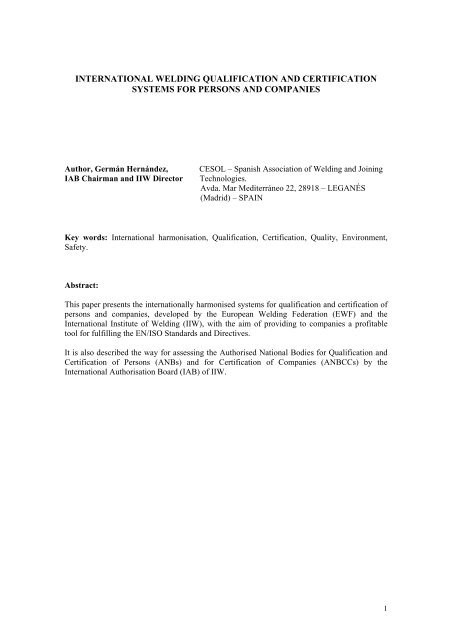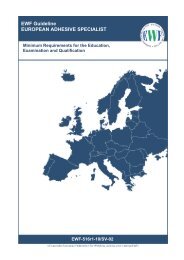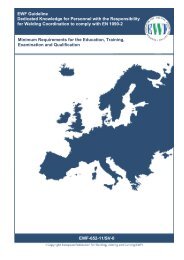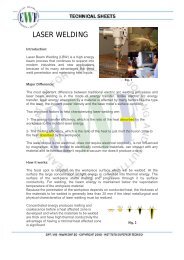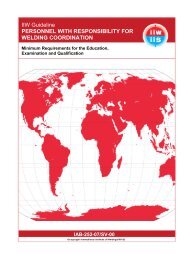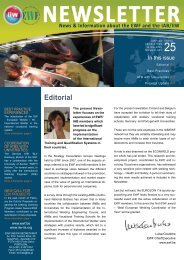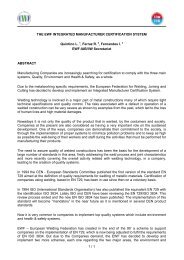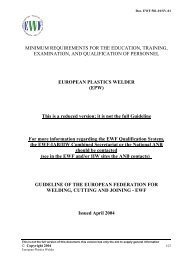International welding qualification and certification systems - EWF
International welding qualification and certification systems - EWF
International welding qualification and certification systems - EWF
Create successful ePaper yourself
Turn your PDF publications into a flip-book with our unique Google optimized e-Paper software.
INTERNATIONAL WELDING QUALIFICATION AND CERTIFICATION<br />
SYSTEMS FOR PERSONS AND COMPANIES<br />
Author, Germán Hernández,<br />
IAB Chairman <strong>and</strong> IIW Director<br />
CESOL – Spanish Association of Welding <strong>and</strong> Joining<br />
Technologies.<br />
Avda. Mar Mediterráneo 22, 28918 – LEGANÉS<br />
(Madrid) – SPAIN<br />
Key words: <strong>International</strong> harmonisation, Qualification, Certification, Quality, Environment,<br />
Safety.<br />
Abstract:<br />
This paper presents the internationally harmonised <strong>systems</strong> for <strong>qualification</strong> <strong>and</strong> <strong>certification</strong> of<br />
persons <strong>and</strong> companies, developed by the European Welding Federation (<strong>EWF</strong>) <strong>and</strong> the<br />
<strong>International</strong> Institute of Welding (IIW), with the aim of providing to companies a profitable<br />
tool for fulfilling the EN/ISO St<strong>and</strong>ards <strong>and</strong> Directives.<br />
It is also described the way for assessing the Authorised National Bodies for Qualification <strong>and</strong><br />
Certification of Persons (ANBs) <strong>and</strong> for Certification of Companies (ANBCCs) by the<br />
<strong>International</strong> Authorisation Board (IAB) of IIW.<br />
1
INTRODUCTION<br />
The development of European <strong>and</strong> <strong>International</strong> st<strong>and</strong>ards is having a great effect on<br />
manufacturing <strong>and</strong> fabricating companies. Many companies have achieved <strong>certification</strong> to EN<br />
ISO 9001 with respect to their quality management <strong>systems</strong>. But where significant use is made<br />
of a special process like <strong>welding</strong>, such <strong>certification</strong> is unlikely to provide the required<br />
demonstration of capability of the company to manufacture products of the required quality.<br />
EN ISO 9001:2000 considers <strong>welding</strong> a “special process”, meaning that it must be taken into<br />
consideration much before the weld is performed. The way in which a determined <strong>welding</strong><br />
process is applied directly affects the final characteristics of the welded product that, in the end,<br />
has to meet previously set specifications.<br />
The effects that the application of different <strong>welding</strong> processes has on the quality of the welded<br />
joint, the environment <strong>and</strong> the prevention of working hazards must be known from the initial<br />
designing phase, since the consequences are relevant during the <strong>welding</strong> operation, as well as<br />
throughout the life of the equipment or welded product.<br />
The importance of all this has resulted in the publication of numerous regulations defining<br />
conditions in which <strong>welding</strong> processes should be performed, so that they do not seriously affect<br />
the safety of people or environment.<br />
The European Federation for Welding, Joining <strong>and</strong> Cutting, <strong>EWF</strong>, an organisation formed by<br />
Welding Institutes <strong>and</strong> Associations of 31 countries, has also been aware of the importance of<br />
this global <strong>welding</strong> impact <strong>and</strong> initiated in 1987 the definition of the opportune <strong>systems</strong> in such<br />
a way that the quality of the joint, as well as environment <strong>and</strong> personal safety are not negatively<br />
affected by the application of the <strong>welding</strong> processes.<br />
On 17 July 1997, the <strong>International</strong> Institute of Welding, IIW, <strong>and</strong> <strong>EWF</strong> signed in San Francisco<br />
the first agreement of co-operation towards the development of a single international system for<br />
education <strong>and</strong> <strong>qualification</strong> of <strong>welding</strong> personnel. By use of a single syllabus for each type of<br />
training course <strong>and</strong> a central system of control of examinations, the same <strong>qualification</strong> may be<br />
awarded in any country.<br />
In order to administer this system <strong>and</strong> to develop it still further, the IIW established the<br />
<strong>International</strong> Authorisation Board, IAB. This organisation, aimed at the effective integration of<br />
the <strong>EWF</strong> <strong>and</strong> IIW <strong>systems</strong> <strong>and</strong> its implementation in all IIW countries, publishes Guidelines <strong>and</strong><br />
documents for training syllabuses <strong>and</strong> examinations, as well as Rules that assure the required<br />
quality during the implementation of the different schemes described in the established <strong>systems</strong>.<br />
SYSTEM FOR EDUCATION, TRAINING AND QUALIFICATION OF PERSONNEL<br />
The first achievement was the implementation of a harmonised training <strong>and</strong> <strong>qualification</strong> system<br />
in the field of <strong>welding</strong> technology, by publishing a <strong>EWF</strong> Guideline defining the minimum<br />
requirements for the European Welding Engineer in 1992. Today there are available 18<br />
harmonised Guidelines for different levels <strong>and</strong> seven Special Courses, designed to provide a<br />
basic core education <strong>and</strong> training in a specific field related to <strong>welding</strong> processes, covering the<br />
whole spectrum of education <strong>and</strong> training in <strong>welding</strong> <strong>and</strong> related areas.<br />
The education <strong>and</strong> training Guidelines <strong>and</strong> Special Courses developed up to the present are:<br />
• I/EWE, <strong>International</strong>/European Welding Engineer *<br />
• I/EWT, <strong>International</strong>/European Welding Technologist *<br />
• I/EWS, <strong>International</strong>/European Welding Specialist *<br />
• I/EWP, <strong>International</strong>/European Welding Practitioner *<br />
• I/EWIP, <strong>International</strong>/European Welding Inspection Personnel *<br />
• IWSD, <strong>International</strong> Welded Structures Designer *<br />
2
• IW, European Welder *<br />
• EAW, European Aluminothermic Welder<br />
• EDW, European MMA-Diver Welder<br />
• EPW, European Plastic Welder<br />
• ETSS, European Thermal Spraying Specialist<br />
• ETSP, European Thermal Spraying Practitioner<br />
• ETS, European Thermal Sprayer<br />
• EAE, European Adhesive Engineer<br />
• EAS, European Adhesive Specialist<br />
• EAB, European Adhesive Bonder<br />
• EWS-RW, European Welding Specialist for Resistance Welding<br />
• EWP-RW, European Welding Practitioner for Resistance Welding<br />
• Special Course in Laser Welding (Engineer, Technologist <strong>and</strong> Specialist levels)<br />
• Special Course for Robot Welding at the Specialist level<br />
• Special Course for Welding Reinforcing Bars at the Specialist level<br />
• Special Course on Weld Imperfections for Non-Destructive Personnel<br />
• Special Course on Personnel with responsibility for Macroscopic <strong>and</strong> Microscopic<br />
Metallographic Examination<br />
• Special Course on Personnel with responsibility for Heat Treatment of Welded Joints<br />
• Special Course on Risk Management in Welded Fabrication.<br />
* Adopted or developed by the <strong>International</strong> Institute of Welding<br />
The subjects <strong>and</strong> teaching times for the more dem<strong>and</strong>ed Guidelines are:<br />
Education time (hours)<br />
Education module I/EWE I/EWT I/EWS I/EWP<br />
I/EWIP<br />
I/EWI-C I/EWI-S I/EWI-B<br />
(comprehensive) (st<strong>and</strong>ard) (basic)<br />
Welding processes <strong>and</strong> 93 76 45 22 25 13 11<br />
equipment<br />
Materials <strong>and</strong> their<br />
111 82 47 22 52 41 25<br />
behaviour during <strong>welding</strong><br />
Construction <strong>and</strong> design 64 40 22 8 21 17 12<br />
Fabrication, applications 110 80 53 28 24 23 17<br />
engineering<br />
Fundamental practical skills 60 60 60 60 49 23 15<br />
Welding inspection --- --- --- --- 97 63 40<br />
Total 438 338 227 140 268 180 120<br />
SYSTEM FOR CERTIFICATION OF PERSONNEL<br />
Personnel <strong>certification</strong> system provides a simple means by which job capability can be assessed<br />
<strong>and</strong> recognised. It defines the profile of education, knowledge, experience <strong>and</strong> responsibility<br />
required for a range of conventional <strong>welding</strong> tasks <strong>and</strong> provides a professional assessment<br />
procedure.<br />
Safety <strong>and</strong> profit depend on technical control of <strong>welding</strong> operations. Key staff in all <strong>welding</strong><br />
related activities needs to have an appropriate level of competence in <strong>welding</strong> technology <strong>and</strong> its<br />
application. In addiction to employing competent <strong>and</strong> tested welders, manufacturers should<br />
ensure that engineers, designers <strong>and</strong> technicians who deal with <strong>welding</strong> matters have proven<br />
relevant competence. This is increasingly becoming a contract requirement: a trend which is<br />
expected to accelerate as new European Directives <strong>and</strong> St<strong>and</strong>ards for <strong>welding</strong> come into force.<br />
ISO 14731 “Welding Coordination – Tasks <strong>and</strong> Responsibilities” requires people with <strong>welding</strong><br />
related responsibilities to be able to demonstrate that they are competent to carry out those<br />
responsibilities. This st<strong>and</strong>ard makes reference to IIW Qualification System as a way to<br />
demonstrate people’s technical knowledge.<br />
3
Because Certification is concerned with current competence rather than historical attainment,<br />
periodic renewal is required. The system provides a convincing way of supporting companies<br />
seeking to achieve compliance with ISO 14731.<br />
Four levels of <strong>certification</strong> are available, based on the four main Diplomas: E/IWE, E/IWT,<br />
E/IWS <strong>and</strong> E/IWP. The first three of these <strong>qualification</strong>s are deemed to satisfy the technical<br />
knowledge requirements of ISO 14731. The <strong>certification</strong> requirements are established in the<br />
document IAB- 341-08 “Rules for the implementation of IIW scheme for <strong>certification</strong> of<br />
personnel with Welding Coordination Responsibilities”, the steps considered are:<br />
Technical knowledge requirement:<br />
“<strong>International</strong> Welding Engineer”<br />
(<strong>EWF</strong>/IIW Diploma)<br />
Two years recent experience:<br />
relevant job content <strong>and</strong> level<br />
Demonstration of maintaining <strong>and</strong><br />
developing technical knowledge<br />
ANB assessment<br />
Issue of certificate<br />
“Certified <strong>International</strong> Welding Engineer”<br />
(Renewed every three years by repeating steps 2, 3 <strong>and</strong><br />
4 above – “Surveillance”)<br />
Certification Title<br />
Certified <strong>International</strong> Welding Engineer<br />
Certified <strong>International</strong> Welding Technologist<br />
Certified <strong>International</strong> Welding Specialist<br />
Certified <strong>International</strong> Welding Practitioner<br />
Certification <strong>and</strong> Qualification Titles<br />
SYSTEM FOR CERTIFICATION OF COMPANIES<br />
This system includes the following three schemes:<br />
Welding Knowledge Qualification<br />
Required<br />
<strong>International</strong> Welding Engineer<br />
<strong>International</strong> Welding Technologist<br />
<strong>International</strong> Welding Specialist<br />
<strong>International</strong> Welding Practitioner<br />
IIW Scheme for Certification of Manufacturers of Welded Products according to ISO<br />
3834, to determine <strong>welding</strong> quality level as stipulated in the series of st<strong>and</strong>ards ISO 3834 <strong>and</strong> in<br />
accordance with EN 45011 st<strong>and</strong>ard.<br />
Scheme for Certification of Manufacturers of Welded Products according to <strong>EWF</strong><br />
Environmental Management System, to comprehend <strong>and</strong> evaluate environmental effects of<br />
the <strong>welding</strong> process application as stipulated in EN ISO 14001 <strong>and</strong> EN 14717st<strong>and</strong>ards.<br />
Scheme for Certification of Manufacturers of Welded Products according to <strong>EWF</strong> Safety<br />
Management System, to comprehend <strong>and</strong> prevent labour accidents related to <strong>welding</strong> <strong>and</strong> its<br />
allied technologies, such as thermal cutting, thermal spraying, grinding, etc.<br />
4
These schemes are applied according to rules, also harmonized, which lead to the mutual<br />
recognition of certificates issued by any of the duly authorised national organisations <strong>and</strong> that<br />
are accomplished by persons within those organisations who:<br />
• are fully qualified in <strong>welding</strong> <strong>and</strong> its allied technologies, minimum<br />
European/<strong>International</strong> Welding Technologist,<br />
• have three-years minimum experience in welded fabrications, as well as in quality<br />
<strong>systems</strong>,<br />
• have added experience in the application of the most relevant national <strong>and</strong> international<br />
st<strong>and</strong>ards on welded constructions,<br />
• are in continued contact with organisations in charge of elaborating rules for the<br />
fabrication, inspection <strong>and</strong> maintenance of welded constructions.<br />
The final objective of the three schemes already mentioned is to offer, to companies using<br />
<strong>welding</strong> as an important part of their productive process, <strong>certification</strong>s that give, among other<br />
things, greater confidence to their Clients, Personnel, Stockholders <strong>and</strong> Community at large.<br />
IIW SCHEME FOR CERTIFICATION OF MANUFACTURERS OF WELDED<br />
PRODUCTS ACCORDING TO ISO 3834<br />
EN ISO 9001:2000 st<strong>and</strong>ard, in combination with EN ISO 3834 series of st<strong>and</strong>ards, assure that<br />
<strong>welding</strong> <strong>and</strong> its related processes are adequately controlled so that a Customer, or any other<br />
body, may have the confidence that the “special process” of <strong>welding</strong> is carried out properly <strong>and</strong><br />
that the welded product will comply with the contract <strong>and</strong>/or application st<strong>and</strong>ard.<br />
EN ISO 3834 “Quality Requirements for Welding. Fusion Welding of Metallic Materials”, has<br />
six parts whose headlines are self-explanatory:<br />
• Part 1: Criteria for selection of the appropriate level of quality requirements,<br />
• Part 2: Comprehensive quality requirements,<br />
• Part 3: St<strong>and</strong>ard quality requirements,<br />
• Part 4: Elementary quality requirements,<br />
• Part 5: Documents with which is necessary to conform to claim conformity to the<br />
quality requirements of EN ISO 3834-2, EN ISO 3834-3 or EN ISO 3834-4,<br />
• Part 6: Guidelines on implementing EN ISO 3834-2 (EN ISO/PDTR 3834-6).<br />
In conjunction with EN ISO 9001, Part 2 is the applicable st<strong>and</strong>ard with the requirements<br />
minimised to suit the range of welded constructions defined in the scope of the manufacture’s<br />
Quality Management System <strong>certification</strong>.<br />
The applicable part of EN ISO 3834 (Part 2, 3 or 4) for independent assessment <strong>and</strong> <strong>certification</strong><br />
of <strong>welding</strong> operations <strong>and</strong> activities (EN 45011), will depend on the nature of the <strong>welding</strong><br />
activities required to meet the agreed specifications <strong>and</strong> will be influenced by how critical the<br />
<strong>welding</strong> operations are to the quality <strong>and</strong> fitness of the final product.<br />
The collaboration with EA, European co-operation for Accreditation, uniquely brought together<br />
expertise in accreditation criteria <strong>and</strong> expertise in manufacturing by <strong>welding</strong>. This ensured that<br />
the special requirements of <strong>welding</strong> technology were properly accounted for, resulting in a<br />
technical set of sound accreditation criteria, which can be applied uniformly by accreditation<br />
bodies throughout Europe. Presently, the IIW Manufacturer Certification Scheme for the<br />
Management of Quality in Welding is described in the documents:<br />
5
• EA-6/02, EA Guidelines on the use of EN 45011 <strong>and</strong> ISO/IEC 17021 for Certification<br />
to EN ISO 3834.<br />
• IAB-337-08, Interpretation <strong>and</strong> implementation of ISO 3834 requirements.<br />
• IAB-338-08, Supplement for the implementation of ISO 3834 oriented to welded<br />
products.<br />
• IAB-339-08, Rules for ANBCCs operating the IIW Manufacturer Certification Scheme.<br />
• IAB-340-08, ANBCCs assessment of manufacturers of welded products operating the<br />
IIW Manufacturer Certification Scheme.<br />
Benefits for fabricating companies<br />
EN ISO 3834 <strong>certification</strong> can be achieved independently (in accordance with EN 45011) or<br />
alongside EN ISO 9001 <strong>certification</strong> (in accordance with EN 45012). Obtaining EN ISO 3834<br />
<strong>certification</strong>, in accordance with IIW harmonised system, offers companies the following<br />
benefits:<br />
• Clear, high profile, independent verification of compliance by the world’s leading<br />
authority on <strong>welding</strong>.<br />
• Facilitate compliance with emerging European <strong>and</strong> <strong>International</strong> st<strong>and</strong>ards that call up<br />
EN ISO 3834 namely the EU Directives.<br />
• Confirmation of <strong>welding</strong> <strong>and</strong> fabricating capabilities <strong>and</strong> staff competence.<br />
• Improved client confidence leading to a reduction of external audits.<br />
• Entry of the company’s details on well-publicised international Web site register.<br />
• Quality management <strong>and</strong> fabrication capability assessments carried out by special<br />
assessors.<br />
• Increased national <strong>and</strong> international business potential.<br />
• Cost savings in production.<br />
• Certification packages to suit individual company requirements.<br />
Registration of capability<br />
<strong>EWF</strong> maintains a register of fabricators that have gained <strong>certification</strong> under the EN ISO 3834<br />
<strong>welding</strong> manufacturer <strong>certification</strong> system; information contained in the register about<br />
companies <strong>and</strong> their capability is made freely available to enquirers worldwide through the<br />
<strong>EWF</strong> web page www.ewf.be. This provides an important sales benefit to certified companies.<br />
SCHEME FOR CERTIFICATION OF MANUFACTURERS OF WELDED PRODUCTS<br />
ACCORDING TO <strong>EWF</strong> ENVIRONMENTAL MANAGEMENT SYSTEM (EMS)<br />
Environment management is now a key issue for manufacturing companies. The international<br />
St<strong>and</strong>ard EN ISO 14001 “Environmental Management System – Specification with Guidance<br />
for Use”, is the key document in this area <strong>and</strong> <strong>systems</strong> that comply with this can be integrated<br />
with EN ISO 9001 Quality Management Systems.<br />
Fabrication by <strong>welding</strong> is a complex process that cannot be limited to <strong>welding</strong> alone. Therefore,<br />
a range of activities needs to be considered <strong>and</strong> dealt with.<br />
<strong>EWF</strong> has recognised this <strong>and</strong> has developed a series of documents on Environmental<br />
Management Systems, EMS, “best practises” for companies that use <strong>welding</strong> as a<br />
manufacturing process.<br />
Presently, the <strong>EWF</strong> Manufacturer Certification System for the Management of Quality,<br />
Environment <strong>and</strong> Health <strong>and</strong> Safety in Welding Fabrication comprises the following documents:<br />
6
• EA-6/02, EA Guidelines on the use of EN 45011 <strong>and</strong> ISO/IEC 17021 for<br />
Certification to EN ISO 3834.<br />
• <strong>EWF</strong>-636-07, Management Schemes, Interpretation <strong>and</strong> Implementation.<br />
• <strong>EWF</strong>-637-07, Supplement for the implementation of EN ISO 3834 oriented to<br />
Welded Products.<br />
• <strong>EWF</strong>-638-07, Rules for ANBCCS Operating the <strong>EWF</strong> Manufacturer Certification<br />
System.<br />
• <strong>EWF</strong>-639-07, ANBCC’s Assessment of a Manufacturer of Welded Products<br />
Operating the <strong>EWF</strong> Manufacturer Certification System.<br />
Welding Fabrication <strong>and</strong> Environment<br />
In previous years the attention to the environment paid by the industrial world has grown higher<br />
<strong>and</strong> higher. There has not only been a series of flourishing events devoted to this matter all over<br />
the world, but some of the most important enterprises have already started asking their<br />
subcontractors to implement an environmental management system. In order to make available<br />
to companies a correct <strong>and</strong> homogeneous approach in this specific field, an international<br />
st<strong>and</strong>ard, EN ISO 14011 “Environmental management system-specifications with guidance for<br />
use”, had been prepared with the aim to provide the needed references for the application of an<br />
effective scheme. This st<strong>and</strong>ard adopts the general principles of the EN ISO 9001, with the<br />
possibility to share <strong>and</strong> integrate both management <strong>systems</strong> by companies willing:<br />
• to implement, maintain <strong>and</strong> improve an environmental management system;<br />
• to demonstrate the fitness of their environmental politics to other private or public<br />
parties;<br />
• to seek <strong>certification</strong> of their environmental management system by an external<br />
accredited organization.<br />
Even if the fabrication by <strong>welding</strong>, with the manufacturing <strong>and</strong> testing processes involved, is<br />
not mentioned among the most polluting activities, a significant number of precautions are to be<br />
taken <strong>and</strong> the relevant actions enforced, as duly reported in the course of the present paper.<br />
The EN ISO 14001, dealing with the matter as a whole, is non-oriented to solve specific<br />
environmental problems raised by <strong>welding</strong> fabrication; therefore, an interpretation of the<br />
st<strong>and</strong>ard itself by <strong>welding</strong> experts is needed. This is precisely what <strong>EWF</strong> has done through a<br />
special working group aimed at this purpose. Not only the different fabrication phases need to<br />
be identified <strong>and</strong> the relevant aspects <strong>and</strong> impacts defined <strong>and</strong> quantified as much as possible,<br />
but also a specific educational path for the engaged personnel must be identified <strong>and</strong> proposed.<br />
Not to double the work, all activities have been carried out taking into account what goes on in<br />
other international organisations, namely the CEN TC 121 “Welding” <strong>and</strong> the Select Committee<br />
“Environment” of IIW.<br />
Generic Requirements for an Environmental Management System, EMS<br />
• Preliminary Analysis of the effect on the surrounding environment, namely<br />
• Emissions to air<br />
• Releases to water<br />
• Waste management<br />
• Contamination of l<strong>and</strong><br />
• Use of raw materials <strong>and</strong> natural resources<br />
• Other local environmental <strong>and</strong> community issues<br />
• Environmental analysis report where the actual situation is compared with:<br />
• Legislative <strong>and</strong> regulatory requirements<br />
• Advanced practise applied in the Industrial Sector of the company<br />
7
• Effectiveness of the resources possibly already devoted to<br />
environmental aspects.<br />
• Environmental management programme considering:<br />
• Technical activities.<br />
• Improvement of the relationship with the environment.<br />
• Review of environmental policies.<br />
Competence in developing <strong>and</strong> implementing an EMS is important, particularly when special<br />
processes like <strong>welding</strong> are involved. The related personnel must be competent to provide<br />
adequate response to the completeness of the environmental analysis, the fitness of the<br />
environmental practice (if one exists) <strong>and</strong> the fitness of the environmental programme designed.<br />
The same competence is required to the auditors involved in assessing the compliance of an<br />
EMS according to EN ISO 14001.<br />
SCHEME FOR CERTIFICATION OF MANUFACTURERS OF WELDED PRODUCTS<br />
ACCORDING TO <strong>EWF</strong> SAFETY MANAGEMENT SYSTEM (SMS)<br />
This <strong>certification</strong> system is still in prototype phase. Until EN st<strong>and</strong>ards regarding this matter are<br />
published, this system will be considered as “Good Practise” not submitted to a <strong>certification</strong><br />
process.<br />
It is planned that the definition of <strong>EWF</strong> Safety Management System, SMS, should include, at<br />
least:<br />
• Basic terms <strong>and</strong> definitions regarding safety<br />
• Identification of safety indicators<br />
• Analysis of hazards <strong>and</strong> risks<br />
• Planning preventive <strong>and</strong>/or corrective actions to be taken by the Manufacturer to meet<br />
safety requirements<br />
• Related economic evaluation<br />
• Approach to the continuous improvement of safety in the <strong>welding</strong> production process.<br />
The SMS will be designed, realised <strong>and</strong> presented to the Manufacturer of Welded Product in<br />
such a way that he may choose one of the following possibilities:<br />
• A st<strong>and</strong>-alone scheme.<br />
• A complementary part of the IIW ISO 3834 scheme.<br />
• A complementary part of the <strong>EWF</strong> EMS scheme.<br />
• A complementary part of the IIW ISO 3834 <strong>and</strong> <strong>EWF</strong> EMS scheme.<br />
The implementation of <strong>EWF</strong> SMS should take into consideration the steps indicated in the<br />
following flow diagram:<br />
8
Definition of<br />
Company Safety Policy<br />
on Welding Activities<br />
National Law, Rules<br />
<strong>and</strong> Regulation<br />
support<br />
Identification of Welding<br />
Activities <strong>and</strong> Areas<br />
Evaluation of Welding<br />
Hazards <strong>and</strong> Risks<br />
Maintain <strong>and</strong> Improve<br />
<strong>EWF</strong> SMS<br />
Analysis of<br />
Current Safety Situation<br />
Comparison with<br />
Predefined Company<br />
Safety Welding Policy<br />
Preventive Actions<br />
Implementation, if any<br />
Adoption of<br />
Corrective <strong>and</strong><br />
Preventive Actions<br />
Definition of<br />
Economic Impact<br />
Definition of<br />
Dedicated <strong>and</strong> Needed<br />
Resources<br />
Settlement of Activities<br />
Time Schedule<br />
Corrective Actions<br />
implementation<br />
IMPLEMENTATION OF THE INTERNATIONAL HARMONISED SYSTEMS<br />
The uniform application of previously described <strong>qualification</strong> <strong>and</strong> <strong>certification</strong> <strong>systems</strong> is<br />
guaranteed by appointing one organisation in each country to act on behalf of IIW/<strong>EWF</strong>. These<br />
organisations, assessed <strong>and</strong> monitored against specific rules, are known as Authorised National<br />
Bodies for Qualification <strong>and</strong> Certification of Persons (ANBs) or Authorised National Bodies<br />
for Certification of Companies (ANBCCs), being responsible for ensuring that the international<br />
st<strong>and</strong>ards of <strong>qualification</strong> <strong>and</strong> <strong>certification</strong> are maintained. The objective is that the Qualified<br />
Person, or Certified Company, will have demonstrated that they have achieved an identified<br />
minimum level of capability for a specific scope of activity, irrespective of the country in which<br />
they have been qualified <strong>and</strong>/or certified.<br />
It is the role of the ANBs to act in its own country for IIW/<strong>EWF</strong> in respect to personnel<br />
<strong>qualification</strong>, including:<br />
9
• The approval of ATBs (Training Centres) for the conduct of courses in accordance with<br />
IIW/<strong>EWF</strong> Guidelines,<br />
• To conduct the examinations,<br />
• The <strong>qualification</strong> <strong>and</strong> <strong>certification</strong> of personnel <strong>and</strong> the recording of relevant information.<br />
Presently the following 37 countries participate in this system <strong>and</strong> have the corresponding ANB:<br />
Australia, Austria, Belgium, Brazil, Bulgaria, Canada, P.R. of China, Croatia, Czech Republic,<br />
Denmark, Finl<strong>and</strong>, France, Germany, Hungary, India, Italy, Iran, Japan, Netherl<strong>and</strong>s, Nigeria,<br />
Norway, Pol<strong>and</strong>, Portugal, Romania, Russia, Serbia, Singapore, Slovakia, Slovenia, South<br />
Africa, Spain, Sweden, Switzerl<strong>and</strong>, Thail<strong>and</strong>, Ukraine, United Kingdom <strong>and</strong> United States.<br />
Another five countries, Egypt, Greece, Indonesia, South Korea <strong>and</strong> Turkey, have applied to<br />
become ANBs.<br />
The personnel <strong>certification</strong> system is becoming more popular every day <strong>and</strong> has been<br />
implemented in the following eleven countries: Australia, Belgium, Croatia, Czech Republic,<br />
France, Germany, Italy, Pol<strong>and</strong>, Romania, Slovakia <strong>and</strong> United Kingdom.<br />
The role of ANBCCs is to act on behalf of IIW/<strong>EWF</strong> in respect to company <strong>certification</strong>,<br />
including the conduct of company assessment (either directly or through Participating<br />
Assessment Bodies), the <strong>qualification</strong> of ANBCC Assessors, the issuing of the certificate <strong>and</strong><br />
the recording of all relevant information during the <strong>certification</strong> process.<br />
At present, the following countries have an ANBCC:<br />
• In accordance with IIW ISO 3834 Scheme: Australia, Austria, Croatia, Czech Republic,<br />
France, Germany, Hungary, Italy, Iran, Netherl<strong>and</strong>s, Pol<strong>and</strong>, Romania, Slovakia,<br />
Slovenia, South Africa, Spain, Ukraine <strong>and</strong> United Kingdom.<br />
• In accordance with <strong>EWF</strong> EMS: Hungary, Italy <strong>and</strong> Romania.<br />
• In accordance with <strong>EWF</strong> SMS: Hungary <strong>and</strong> Italy.<br />
Additional <strong>and</strong> updated information can be obtained from your national ANB/ANBCC or<br />
visiting www.ewf.be or www.iiw-iis.org Web sites.<br />
10


